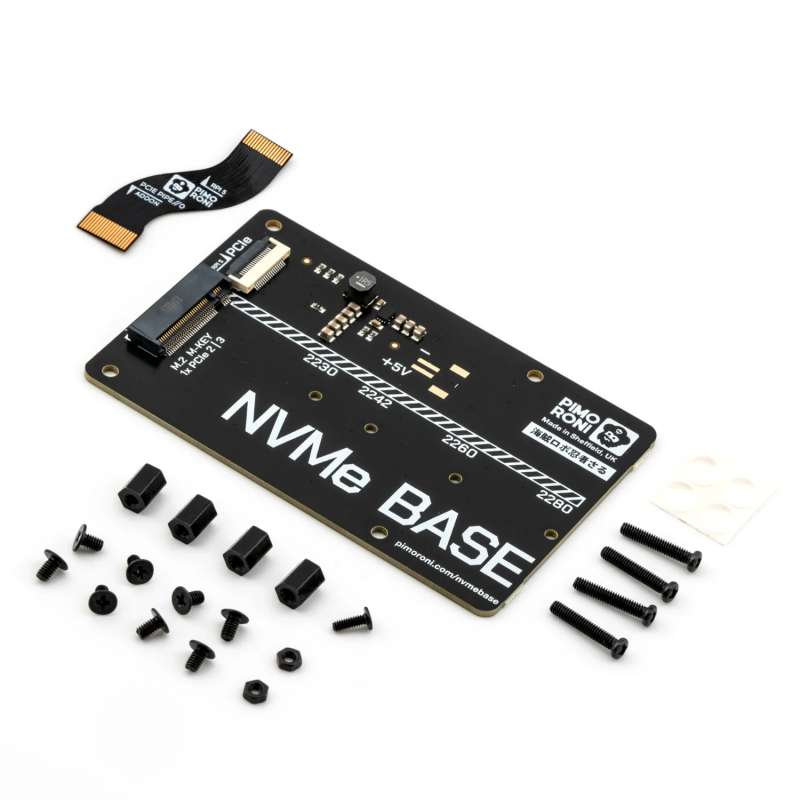


RLX COMPONENTS s.r.o. , Electronic Components Distributor.
RLX COMPONENTS s.r.o. , Electronic Components Distributor.
NVMe Base for Raspberry Pi 5 (PIM699)
NVMe Base je rozširujúca doska PCIe pre Raspberry Pi 5. Jednoducho ju osadíte SSD diskom NVMe s kľúčom M (podporované veľkosti 2230 až 2280) a pripevníte ju pod počítač Pi, čím získate kompaktné a rýchle úložné riešenie - dodáva sa dokonca s gumovými nožičkami! Je to ideálne riešenie na premenu počítača Raspberry Pi 5 na súborový server, mediálne centrum, reverzný proxy server atď. - naozaj akúkoľvek úlohu, ktorá ťaží z veľkého množstva rýchleho úložiska, najmä pri náhodnom zaťažení s vysokým počtom operácií za sekundu (IOPS). Stručne povedané, je to nástroj, ktorý mení pravidlá hry! NVMe Base sa riadi novými usmerneniami pre dizajn „PIP“, ktoré poskytuje Raspberry Pi, čo zaručuje, že sa bude ľahko používať a bude dlhodobo podporovaný aktualizáciami operačného systému Raspberry Pi.
Základná súprava
NVMe Base + SSD Bundle
We also offer the kit bundled with a 250GB, 500GB, 1000GB or 2000GB NVMe SSD (PCIe Gen 3 or better). The Raspberry Pi 5 will run at PCIe 3.0 x 1 speeds at best, even though this mode is unsupported officially, so most drives are limited to around 700-800MB/s read and 350-450MB write at peak. Due to the tides and vagaries of the SSD market, we will ship whichever drive offers the best value for decent specs. We can say that:
We have tested NVMe Base with the following M.2 NVMe drives successfully. We have usually tested one drive from one batch, so this is not comprehensive, or an 'Approved' list, but it's a good guide for drives to seek out:
' Maybe' List. Works with quirks/not ideal.
These drives either needed extra power, were a bit quirky when we tested them or we've had reports of them being problematic. It may just be the drive we had, but they're probably best avoided.
'Avoid' List. We've had problems or reports of problems.
Otherwise most M.2 NVMe drive (Not SATA!) you have lying around should work fine.
Check out our benchmark results over at pibenchmarks.net!
For the most hassle-free experience, make sure your Raspberry Pi OS is up to date, and your RPi 5 firmware is updated to 2023-12-06 (Dec 6th) or newer. This supports all the features of the RPi PCIe spec and means you don't have to mess with config files to get started.
Software update on the RPi OS should do this for you, but to force it you can:
sudo raspi-config and choose 'Latest' under Advanced Options > Bootloader Version.Running sudo rpi-eeprom-update in the Terminal will tell you which version of firmware is running.
To enable experimental and not-officially-supported PCIe 3 mode, add the follow line to the [all] section at the end of your Raspberry Pi /boot/firmware/config.txt file like this:
[all]
dtparam=pciex1_gen=3Save and reboot - your drive is ready to use!
If you want to boot from the NVMe drive, follow these extra steps:
sudo raspi-config